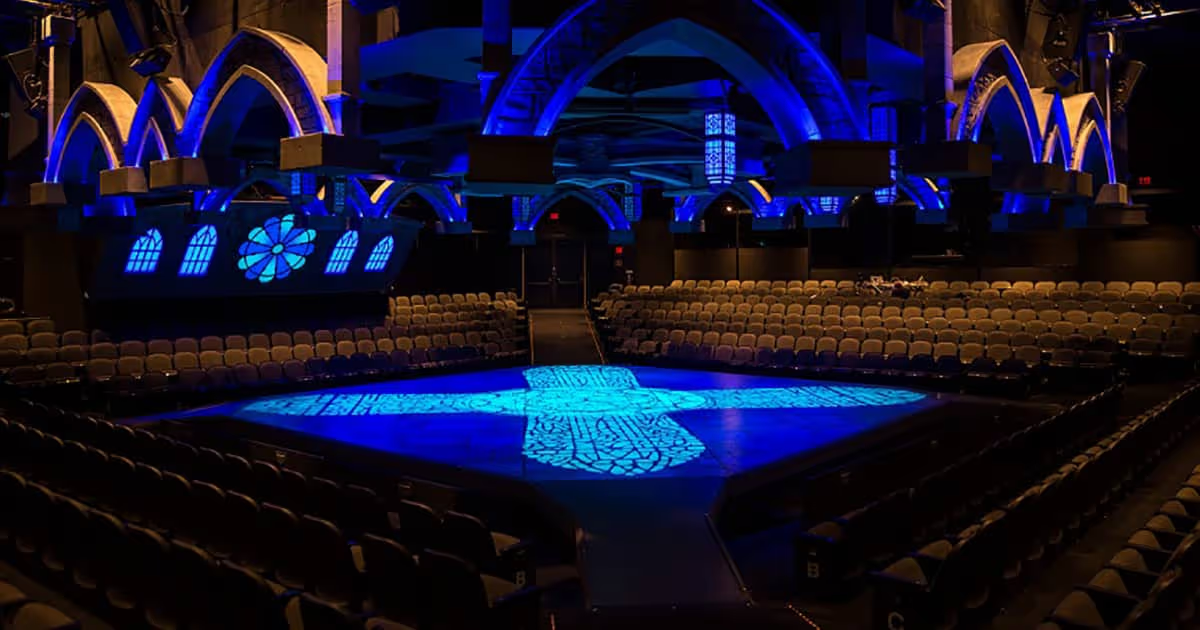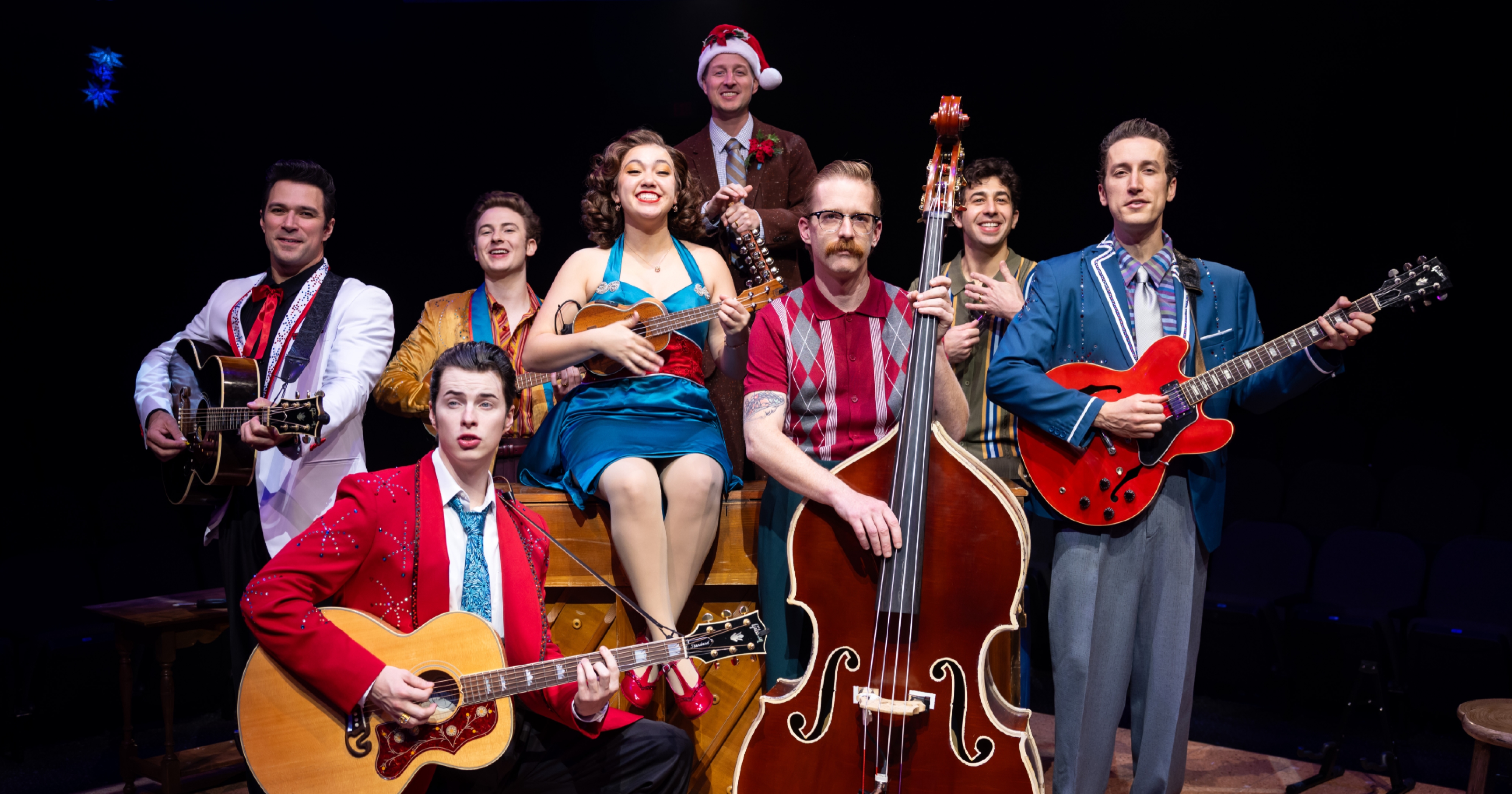“Million Dollar Quartet Christmas”
***** Highly energetic and vibrant, Marriott Theatre’s “Million Dollar Quartet Christmas” is a tribute to rock ’n’ roll in the highest, and it’s sure to knock your (bobby) socks off! This ninety-minute musical is a knock-off from the original “Million Dollar Quartet”, where Sam Phillips, of Sun Records, brought Johnny Cash, Jerry Lee Lewis, Carl Perkins, and Elvis Presley to play together for the first and only time on December 4, 1956. These four young entertainers, plus Phillips, Elvis’s girlfriend Dyanne, Brother Jay (the bass player) and Fluke (the percussionist), make up the characters for this show. But in addition to having them sing the songs that made them famous, this Christmas version has added all sorts of holiday numbers: some originally sung by the artists themselves plus traditional and modern melodies which have been “rock ’n’ rolled up.”
Colton Sims, who plays Elvis, is the lead singer for many songs. Although he doesn’t resemble “The King” in countenance, his voice is resonant and appropriate. Most importantly, he has mastered Elvis’s charisma, hip gyrations, leg shakes, footwork, toe-taps, and heel pivots, combined with exceptional guitar playing. To give you an indication of how talented he is: at one point during Wednesday night’s performance, a string on his guitar broke, and yet Sims continued to play it expertly. Ross Griffin (as Sam Phillips) then walked over and seamlessly handed him a replacement guitar. I also watched as Sims smoothly shifted from acoustic guitar in one number to electric in the next. Similarly, I enjoyed seeing the multi-talented Trevor Lindley Craft, who plays Carl Perkins, travel the stage as he sang and performed on electric guitar—while carefully avoiding the cables on the floor. Michael D. Potter, who plays Johnny Cash, has his prototype’s deep bass voice as well as some of his looks, together with his locomotive-like strum and his deliberate, forward-driving walk. Yet the highest energy comes from JP Coletta, who entertains us as Jerry Lee Lewis. Alone, his antics and versatility give this production five-stars! In addition to his singing, he physically jumps on and off the upright piano; tickles the ivories while sitting, standing, and crouching; plays glissando beautifully; and hits the appropriate keys with his foot. How utterly amazing! Teah Kiang Mirabelli sings beautifully as Dyanne, and she plays the ukulele too, while Phillips (Griffin) ties the whole production together as he engages with each of the performers and occasionally goes inside the tech booth (that is, the real tech booth for the Marriott Theatre). After all, he needs to do his job as a muckamuck running a recording studio!
While the story is fairly thin (as can be expected in a jukebox musical), we nevertheless come to understand a bit about the characters’ backgrounds. We also witness the lighting of a small Christmas tree in the corner of the stage, and there is some amount of gift giving among the characters.
Then there is the incredible directing by Scott Weinstein, who makes sure that the actors use every part of the 360-degree stage and always present themselves to the audience. We watch them regularly shift around and sometimes reverse roles during the same song—and then move on to a different part of the stage for the next number. I especially liked the segments when Dyanne (and later Carl) stands on the double bass and when everyone gathers ’round the piano which is being spun around as they all sing together. But it’s in the constant motion throughout where the beauty of this production lies. I honestly wondered how the cast will be able to replicate their astonishing performances every night, considering how much momentum is constantly being built up and how much energy goes into any one show.
In the original version of “Million Dollar Quartet” (written by Colin Escott and Floyd Mutrux), Phillips would have been sizing up the lead artists by having them make demos in his recording studio. Then the audience would have observed how each one would sing their own songs while the others would freeze up. In today’s version (written by Colin Escott), the artists still create demos but no one freezes, and it’s wonderful to see how well they all perform as a team and play backup as needed.
Milo Bue’s set design, among other things, includes a 360-degree music staff above the stage, made up of thick wires which line the ceiling, replete with wire plates that initially look like vinyl records. This feeds into the incredible lighting design by Jesse King, where the plates turn into colorful flashing lights, together with the flashing and crawling lights on three of the walls towards the end of the show. In contrast, during much of the performance, we see the word “Recording” being lit up above the set in all four corners (for after all, the recording is in progress), and later we see the word “Sun” to denote that that’s the name of the studio. And who could forget the intentional power surge? This is an extremely high voltage production in more ways than one!
Sound design and mix are done well by Michael Daly, and we could hear the words and music clearly. Dialect coach Susan Gosdick should also be commended for the imparting of Southern accents to the cast. Then there’s Sally Zack’s property design. The tech booth is decorated in gold and platinum records and plaques and includes vintage photos. The theatre-in-the-round features a Christmas tree in one corner and, of course, a number of gift-wrapped boxes. Costume design by Nicholas Hartman adds visual interest. All the characters’ casual clothing is nicely appropriate for the era and setting, especially Johnny Cash’s black outfit and Dyanne’s pink dress. However, I especially liked the diagonal striped pattern on the yoke of Jerry Lee Lewis’s shirt—which only adds to the character’s schtick. Yet the showstopper is the glitzy garb that’s part and parcel of the spectacular finale.
Going back to the show itself, it is absolutely excellent, with its focus on larger-than-life recording artists who have played such a prominent place in America’s popular music. While the retreat to the 1950s might be a reminiscence for some, this bright, light, bouncy production might be a novelty for others. Above all, the twist on familiar Christmas favorites gives the performance added warmth and charm. Since the cast and crew impart a joyousness that can only be felt by showing up in person, this musical is a MUST SEE!











